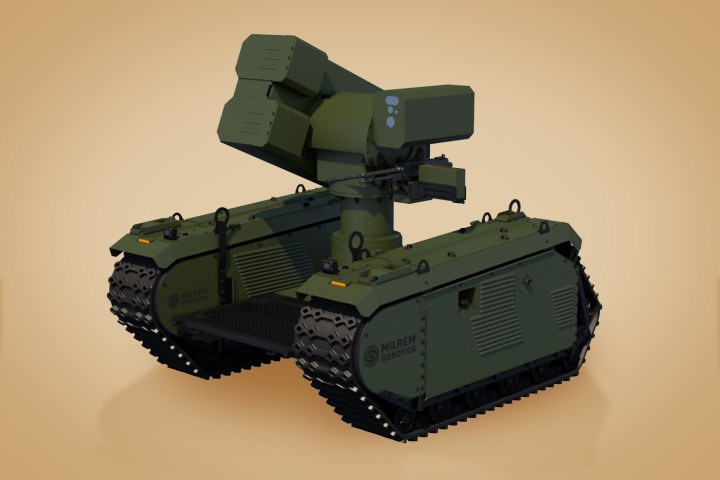
When it comes to cutting-edge tech, for every one project that makes its way into our homes as a consumer-facing product, there are likely several equally (or more) innovative projects designed exclusively for military use. While we won’t ever hear about all of them, we’ve heard enough to have previously written about everything from gun-toting drones to self-guided bullets and robot insect spies. Now, an Estonian defense company called Milrem has teamed up with European missile manufacturer MBDA to create a new unmanned ground vehicle (UGV) that combines a robotics platform called THeMIS with an anti-tank missile capable of taking out enemy tanks at a range of up to 3 miles.
The remote control vehicle can be equipped with up to four anti-tank missiles, each designed to penetrate 39.3 inches of hardened steel armor plating. Oh, and it can carry 1,650 pounds and be kitted out with a robot arm or .50 caliber machine gun to provide cover fire if need be.
“This system will be based on our THeMIS UGV and MBDA’s IMPACT anti-tank system,” Gert Hankewitz, export director for Milrem, told Digital Trends. “At the moment, it is in [the] concept stage. The main idea is the whole reason we have developed the THeMIS: To help or replace soldiers on the battlefield.”
The proposed anti-tank UGV has two main selling points. One is that it will keep soldiers safely away from enemy fire. Secondly, it increases the chance of troops being able to successfully destroy enemies’ heavy equipment. This is because humans give off a heat signature thatg is very difficult to mask, making it more difficult for them to sneak up on enemies without being recognized using thermal imaging technology. But this heat signature is easier to conceal with a UGV — meaning that enemies won’t be able to easily detect the anti-tank weapon before it can get close enough to launch its missiles.
“[THeMIS is] the first fully modular hybrid UGV on the market,” Hankewitz said. “UGVs are mostly designed for one specific purpose, such as IED [explosive] clearing. However, the THeMIS is designed so the same UGV can be used for different tasks, so you can carry different weapon systems — UAV platforms, IED detection and de-mining kits, simple soldiers backpacks, ammunition, and other gear. This approach significantly reduces the life cycle costs of complex unmanned systems.”
Since this project is still in the research and development stage, Hankewitz said there is not yet a publicly announced release date. As to possible deployment, he noted that: “We would like to see them used by NATO forces and other friendly defense forces around the world.”


